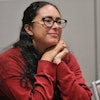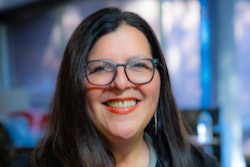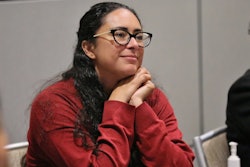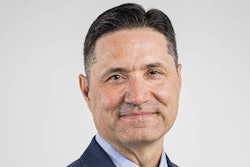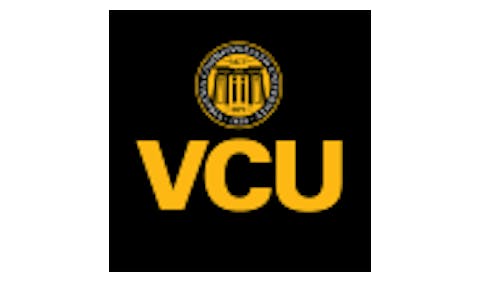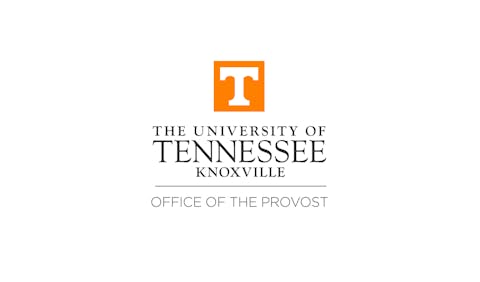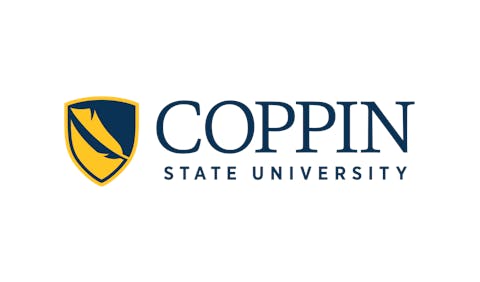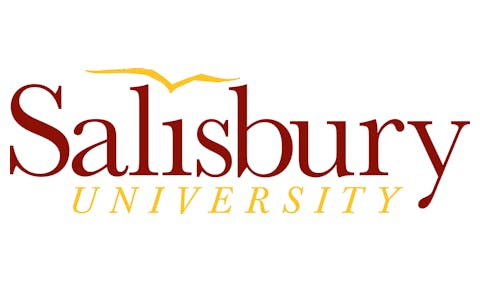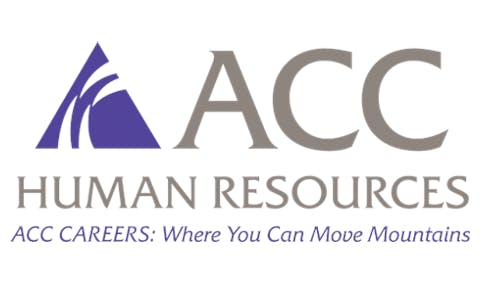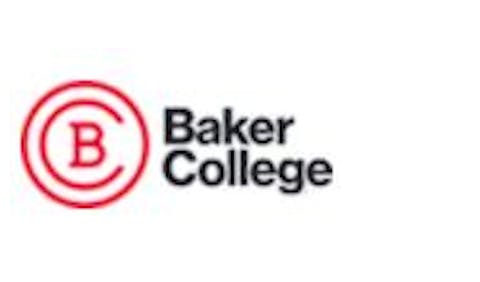 Ghana Hylton
Ghana Hylton
The achievement also reflects remarkable demographic transformation at the university, where Hispanic undergraduate enrollment has surged from just 8.7% in 2005 to 29% to- day. Graduate enrollment has similarly climbed from 4.8% to 14.4% over the same period, mirroring national trends that show Latino undergraduate enrollment more than doubling nationwide between 2000 and 2019.
“This designation is more than a recognition of where we are,” says Ghana Hylton, director of campus inclusion and business affairs at Seton Hall. She helped to spearhead the HSI application process alongside a dedicated team. “It’s a launching point for where we can go. The grants we can now apply for will allow us to invest in student success in new ways that will have an even more lasting impact on their lives.”
For student leaders like Lianie Ochoa, a junior psychology major from Richfield,  Lizanni Then
Lizanni Then
The timing of the designation feels particularly significant to student leaders who are aware of broader challenges facing diversity initiatives in higher education. “Especially now with all the attacks on diversity taking place around the country,” Ochoa notes, “I hope that Seton Hall keeps becoming an even safer space, a more welcoming space.”
Building community through cultural connection
Adelante Latino exemplifies the type of student-driven programming that has helped cultivate Seton Hall’s Hispanic community. Under Ochoa’s leadership, the organization creates what she describes as “a safe space here at Seton Hall to bring that representation back on campus and inform people of who we are, who Hispanics are."
The club’s programming balances cultural celebration with meaningful dialogue about the Hispanic student experience.
“Our events are really focused on brain break fun kind of events. So, we have events like red flag or karaoke,” Ochoa explains. “But we also have events that are more geared towards breaking stigmas, where we talk about the difficulties of being a Hispanic, either at a PWI [predominantly white institution] or just in general.”
These conversations foster deep connections among members.
“It creates this really safe and family [environment] — we call each other family — we’re all just bonded and we all love being around each other,” says Ochoa.
Institutional commitment to growth Dr. Lori Tarke
Dr. Lori Tarke
The designation, granted to accredited institutions where Hispanic or Latino students comprise at least 25% of full-time undergraduate enrollment, opens doors to federal funding opportunities specifically designed to strengthen educational capacity and support Hispanic student success.
For Seton Hall, achieving HSI status represents the natural evolution of values embedded in the institution’s founding in 1856. The university was named after Saint Elizabeth Ann Seton, who converted to Catholicism and faced family rejection during an era when the religion was unwelcome in the young United States.
This foundational commitment to inclusion has shaped Seton Hall’s approach to serving diverse student populations.
“The students here don’t need to look like us or even worship like us. They need to be welcomed for who they are,” says Hylton. “That inclusive means inclusive.”
The crown jewel: Joseph A. Unanue Latino Institute
Central to Seton Hall’s success in serving Hispanic students is the Joseph A. Unanue Latino Institute, which Dr. Lori Tarke, the institute’s executive director, describes as “the crown jew- el” of the university’s Hispanic outreach efforts. The institute’s roots trace back 51 years to the Puerto Rican Institute, which began operations in a trailer on campus.
Twenty years ago, the initiative was transformed through a multimillion-dollar gift from the late Joseph A. Unanue — an American businessman and president of Goya Foods, the largest Hispanic–owned food company in the United States — and his wife Carmen Ana. Unanue’s philanthropy led to the institute’s current iteration focused on academic excellence, cultural enrichment, and leadership development.
The institute’s impact on student success has been remarkable. Tarke reports that among Latino Institute scholarship recipients, graduation rates reach between 73% and 100% within four years across different freshman cohorts. Within six years, four out of five cohorts achieved 100% graduation rates, with the fifth cohort reaching 86%.
The institute has awarded more than $2 million in scholar- ships over two decades while offering students immersive experiences in Latino history, culture, and language. Students participate in more than 50 on-campus and community pro-grams annually, from distinguished speaker series to leader- ship workshops and service-learning opportunities.
The institute’s reach extends well beyond Seton Hall’s cam- pus through collaborations with community organizations, cultural institutions, and international partners. Programs like Ella Triunfa (She Triumphs) showcase Latina leaders across various fields, while service-learning trips provide students with transformative experiences in Latin America.
New opportunities
For student leaders like Ochoa, the HSI designation opens possibilities for enhanced programming and support.
“I’m excited to see how this could help my club or any other Hispanic clubs, or even places like the campus Inclusion Center, so that we can all really grow and thrive,” she says.
The designation comes through Seton Hall’s 2024 member- ship in the Hispanic Association of Colleges and Universities (HACU). HACU membership, combined with an HSI designa- tion, opens doors to expanded opportunities including intern- ships, scholarships, leadership development programs, and federal advocacy. It also provides access to a network of peer institutions and resources for continually enhancing campus experiences. While celebrating this achievement, university leaders acknowledge the current challenging environment surrounding HSI funding and diversity initiatives within high- er education. However, both Hylton and Tarke point to their commitment to the university’s core mission regardless of external pressures.
"We are continuing to just live our mission, and we are just continuing what we’ve always done,” says Tarke.
Hylton says that she chooses to focus on consistency rather than external circumstances.
“For me, I only deal with what’s going on today,” she says. “While we have the status and while we’re able to apply for things that we can get because of the status, we will do that. If that changes, we will continue to nurture and grow our differ- ent populations of students because that’s in the best interest of our school and our community.”
A model for inclusive excellence
Seton Hall’s achievement comes at a crucial time for American higher education. Federal projections indicate Hispanic students will comprise 30% of the undergraduate population nationwide by 2030, underscoring the growing importance of Hispanic-Serving Institutions in shaping higher education’s future.
The collective network of HSIs now serves more than 5.6 million students, representing a critical infrastructure for educational opportunity and economic mobility within Hispanic communities.
Students like Ochoa, who chose Seton Hall for its tight-knit community and beautiful campus, and Lizanni J. Then, a sophomore, who was drawn to the welcoming environment after attending a large high school, represent the institution’s success in attracting and retaining Hispanic students from diverse backgrounds.
“I have absolutely loved my decision to come here and have never regretted it, especially becoming more involved on campus,” Ochoa says.
Then echoes this sentiment about Seton Hall’s inclusive environment. “You don’t feel intimidated,” she says. “Everyone is very welcoming.”
As the university approaches its 170th anniversary, the HSI designation represents both culmination and beginning, say university officials. The recognition validates decades of organic growth and intentional inclusion while opening new possibilities for federal funding and program expansion.
The university’s Hispanic Heritage Month celebration, running September 15 through October 15, provides an immediate opportunity to showcase this achievement and its broader commitment to Latino student success.
The achievement also serves as a model for other institu- tions seeking to authentically serve Hispanic students. As Hylton notes, “There are different ways to do this,” but Seton Hall’s approach — rooted in institutional mission, sustained over decades, and supported by dedicated programming and student leadership — offers a replicable framework for inclu- sive excellence.
With its HSI status now secured, Seton Hall stands ready to leverage new opportunities while maintaining the welcoming spirit that has defined its approach to higher education for nearly two centuries. As university and student leaders like Ochoa and Then frequently point out, this designation doesn’t change their fundamental work — it simply provides new tools to do that work even more effectively.


